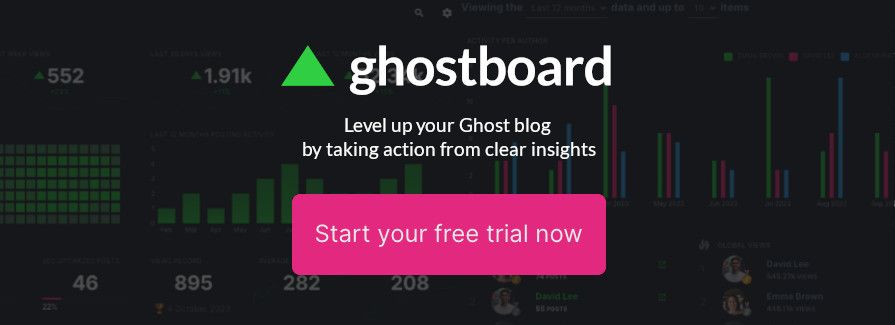7 Tips to Write Better Blog Headlines That Get Clicks 🚀

You’ve poured your heart into your Ghost blog post—crafted thoughtful ideas, polished the writing, added images or embeds—yet the traffic isn’t growing. The missing ingredient? A headline that grabs attention and tells search engines exactly why your post matters.
A strong headline is your blog’s frontline: it’s what readers see on social media, in search results, and on other blogs. It’s the single most important piece of content in your post. Get it right and your clicks (and SEO rankings) will follow. Get it wrong, and your masterpiece stays unread.
This guide offers 7 easy, SEO-informed tips to help you craft headlines that bring clicks. Whether you’re new to content marketing or a seasoned Ghost writer, these simple tactics will sharpen your headline game.
1. Put Your Main Keyword at the Front
✅ Why it works: Search engines give more weight to early words. If your keyword appears in the first 3–5 words, Google is more likely to rank your page higher.
✍️ How to do it:
- Start with: “Ghost Blog SEO Tips” or “Email Marketing Tricks” rather than “Amazing Tips for Ghost Blog SEO”
- Use your keyword naturally. Front-loading doesn’t mean jamming it in awkwardly.
Example:
- Weak: “Tips for Better Blog Headlines”
- Strong: “Blog Headline Tips” or “Headline Tips That Boost Clicks”
2. Use Numbers and Lists
People love digestible bits! “7 Tips,” “5 Strategies,” “10 Secrets”—these formats are clickable and promise structure.
🧠 Psychological edge:
- Odd numbers often outperform even.
- Numbers suggest quick, actionable content.
- Lists are easy to skim—perfect for modern attention spans.
✅ SEO bonus: Numbered headlines are commonly searched. Try: “7 Tips to Write Better Blog Headlines” instead of “Tips to Write Better Headlines.”
3. Add Power Words + Emotional Triggers
Power words stir interest: Ultimate, Proven, Simple, Quick, Free, Secret. Emotional hooks—“surprising,” “mind-blowing,” “must-know”—create curiosity and draw clicks.
Example transformation:
- Basic: “Blog Headline Tips”
- Stronger: “7 Proven Blog Headline Tips That Rock”
- Even stronger: “7 Proven Blog Headline Tips That Skyrocket Clicks 🚀”
⚠️ SEO alert: Use emotional words sparingly—don’t overdo it or sound gimmicky. Always back them up with real value in your content.
4. Match Search Intent and Be Specific
What are your readers searching for? If they look up “how to write headlines for SEO,” your title should reflect that. Use long-tail keywords—phrases like “how to write engaging SEO headlines”—instead of vague terms like “writing better headlines.”
Do this:
- Start with keyword research via tools like Google Keyword Planner or Ubersuggest.
- Identify the top search phrases related to your topic.
- Use a headline like: “How to Write SEO Headlines That Rank (7 Expert Tips)”
5. Keep It Short and Scannable (6–12 Words)
Short headlines work better. Ideal length: 6 to 12 words (or 50–60 characters). This ensures readability and stops truncation in search results and social shares.
📏 Character count matters:
- Twitter, Facebook, and shared links clip long headlines.
- Google Meta Titles display ~50–60 characters max—longer titles get cut off.
Quick test: Draft your headline, then paste it into character-count tools online. Improve it until it meets the sweet spot.
6. Leverage Curiosity—But Deliver Value
Curiosity hooks ("You won’t believe…", "What no one tells you…") can boost clicks. But SEO-wise, you must still include your keyword.
Good format:
“What No One Tells You About Writing SEO Headlines (7 Tips)”
You’ve got the curiosity. You’ve got the keyword. Your headline is click-worthy and optimized.
But don’t promise the moon—deliver on your headline’s promise. If you tease “secret tips,” provide real insights. If it's just fluff, readers will bounce and that hurts SEO.
7. A/B Test Your Headlines
Your instincts are powerful—but hard data is stronger. A/B testing lets you test 2 or 3 headlines against each other.
How to A/B test on Ghost:
- Create multiple headlines for the same post.
- Set the first one
- Run the test for at least a week, or roughly 500 visits.
Track performance: Which headline got more clicks, social shares, time on page, comments?
Rotate tests every few months—reader behavior often shifts with time, season, or trends.
SEO-Focused Checklist ✍️
Before hitting publish, run your headline through this quick checklist:
| ✅ Item | Details |
|---|---|
| Keyword included in first 5 words | Front-load your core SEO term. |
| Headline is 6–12 words or 50–60 characters | Set to avoid truncation and improve clarity. |
| Number or list format | Increases structure appeal ("7 Tips", "5 Ways"). |
| Power/emotional words (sparingly) | Think “Ultimate,” “Proven,” “Simple,” “Quick.” |
| Matches search intent and long-tail SEO | Align headline with actual user search queries. |
| Curiosity triggers—but delivers on promise | Use curiosity with substance-driven content. |
| Considered for A/B testing | Prepare variants and gather performance feedback. |
Real-World Example: “7 Tips to Write Better Blog Headlines That Get Clicks”
Let’s break down why this headline works:
- 7 Tips → Numbered list (digestible, scannable)
- Write Better Blog Headlines → Keyword “blog headlines” and reader intent
- That Get Clicks → Benefit-driven + emotional promise
- ✅ It’s 10 words and ~50 characters—compact and clear
- ✅ Long-tail intent: clear focus for SEO
- ✅ Contains mild curiosity and benefit
In your Ghost dashboard, this title is ideal for SEO, social media, and reader clarity—all at once.
🚀 Try it now!
- Go through your existing posts.
- Pick the ones that underperform.
- Rewrite the headlines using this list.
- Track changes in clicks and SEO ranking over a month.
Comment below if you want help with headline ideas or testing tools on Ghostboard!
Happy writing (and headline crafting)! 🎉
Level up your Ghost blog 🚀
Start your free trial now and explore all Ghostboard features for free. No credit card is required.

